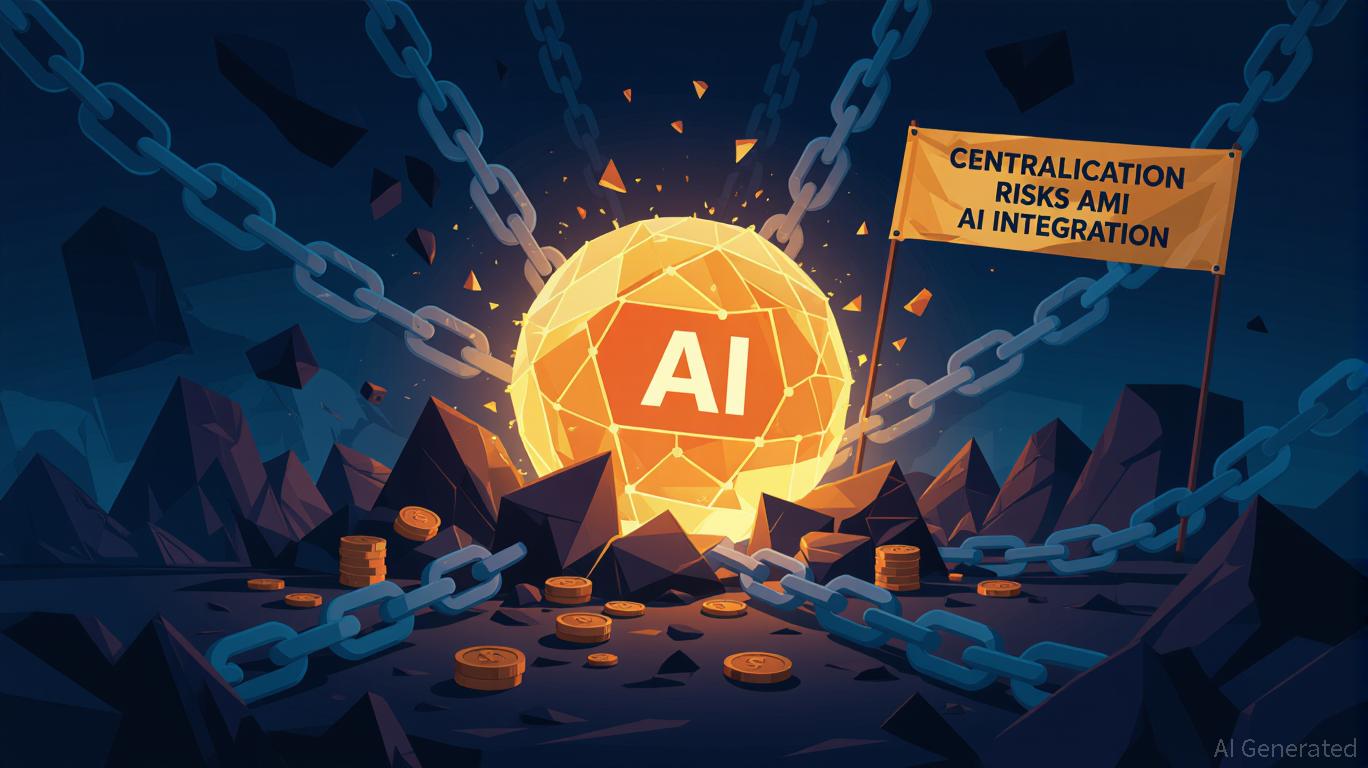The ICP Token Jumps 30%: Is This a Turning Point for AI Infrastructure?
- ICP token surged 30% in 2025, driven by Caffeine AI platform launch and strategic partnerships with Microsoft and Google Cloud. - Chain Fusion protocol enhanced cross-chain interoperability, aligning ICP with AI's demand for diverse data sources and decentralized infrastructure growth. - Market trends show AI compute demand reaching $1.81 trillion by 2030, with ICP positioned to address scalability challenges through distributed cloud solutions. - Energy constraints and regulatory risks remain challenges
ICP Token’s Dramatic Rise and the Transformation of AI Infrastructure
ICP’s token has recently experienced a remarkable 30% price increase, igniting widespread discussion among market participants about its potential to reshape the future of artificial intelligence infrastructure and decentralized cloud computing. By the end of 2025, the token had soared by 45%, propelled by a blend of cutting-edge technology, influential partnerships, and favorable economic conditions. This raises a crucial question: Is this surge a temporary phenomenon, or does it mark ICP’s emergence as a foundational element in the next wave of computing innovation?
Main Drivers of ICP’s Growth
The launch of the Caffeine AI platform served as the primary trigger for ICP’s recent rally. Built on the ICP Network, this decentralized environment empowers developers and organizations to deploy AI models with greater scalability and lower latency, utilizing ICP’s blockchain to distribute computational tasks globally. This development not only broadened ICP’s practical applications but also drew significant institutional attention. Notably, the total value locked (TVL) on the network climbed by 22.5% in the third quarter of 2025, reaching $1.14 billion.

Strategic collaborations have further fueled ICP’s momentum. Partnerships with Microsoft Azure and Google Cloud have integrated ICP’s decentralized framework with established cloud platforms, resulting in hybrid solutions that tackle scalability and cost challenges. These alliances have positioned ICP as a vital connector between centralized and decentralized systems, offering enterprises the flexibility they increasingly demand.
Additionally, the introduction of the Chain Fusion interoperability protocol—which facilitates seamless integration with major blockchains such as Ethereum and Solana—has expanded ICP’s appeal among developers and users seeking cross-chain capabilities. This advancement highlights ICP’s commitment to building a more interconnected blockchain ecosystem, a necessity for AI applications that rely on diverse data sources.
Wider Market Dynamics: AI Computing and Decentralized Cloud Expansion
ICP’s ascent must be viewed within the context of surging demand for AI computing power and the growing adoption of decentralized cloud solutions. According to Netguru, the global AI sector was valued at $391 billion in 2025 and is expected to grow at an annual rate of 35.9%, reaching $1.81 trillion by 2030. This expansion is driven by widespread AI integration across industries, with 78% of companies now leveraging AI in at least one area of their operations. The adoption of generative AI has also skyrocketed, rising from 33% in 2023 to 71% in 2024, intensifying the need for robust, scalable infrastructure.
The decentralized computing sector is also experiencing rapid growth. Research from 2025 indicates that the global decentralized computing market was valued at $9.25 billion in 2024 and is projected to reach $45 billion by 2035, with a compound annual growth rate of 15.5%. Decentralized cloud storage, a key segment of this market, is forecasted to expand from $9.1 billion in 2025 to $61.2 billion by 2034, driven by the need for secure and cost-effective data solutions. ICP’s emphasis on decentralized infrastructure positions it well to meet the needs of organizations seeking alternatives to centralized data control.
However, the rapid scaling of AI infrastructure brings its own set of challenges. Deloitte reports that the surge in AI data centers is straining U.S. power grids, with large-scale facilities demanding over 2,000 megawatts of electricity. This has prompted a reevaluation of traditional data center models, with decentralized networks like ICP’s offering a potential solution by distributing workloads closer to end users and alleviating pressure on centralized resources.
Assessing ICP’s Breakout Potential
ICP’s recent achievements underscore its strategic position at the crossroads of two major trends: the exponential rise of AI and the shift toward decentralized cloud infrastructure. The token’s growth is underpinned by real-world advancements—such as the launch of Caffeine AI, enhanced cross-chain compatibility, and major enterprise partnerships—that address pressing industry needs.
Nonetheless, the sustainability of this momentum depends on effective execution. While the increase in TVL and institutional interest are promising, the broader market faces obstacles including energy limitations and regulatory uncertainties. For ICP to establish itself as a true leader, it must prove that its decentralized approach can scale efficiently and remain secure as demand continues to rise.
Final Thoughts
The recent 30% jump in ICP’s value is more than just a market fluctuation—it signals the growing intersection of AI and decentralized infrastructure. As businesses and developers look for scalable, secure, and interoperable solutions, ICP’s ecosystem is well-placed to capture a significant share of the expanding AI compute and decentralized cloud markets. However, investors should remain vigilant, as the token’s long-term prospects will depend on its ability to overcome infrastructure challenges and sustain innovation. For now, ICP’s surge marks a pivotal chapter in the evolution of AI infrastructure, positioning it as a prominent force in this rapidly changing landscape.
Disclaimer: The content of this article solely reflects the author's opinion and does not represent the platform in any capacity. This article is not intended to serve as a reference for making investment decisions.
You may also like
GameStop's Profit Strategy: Short Sellers, Brick-and-Mortar Stores, and Interest Rate Expectations Intersect
- GameStop (GME) shares rose near 52-week lows amid high short interest and retail-driven speculation, with a potential short squeeze looming as open options activity surged. - Institutional investors cut $5.4B in MicroStrategy (MSTR) holdings, linking crypto-focused MSTR to GME's 2021 meme stock dynamics amid MSCI index exclusion risks. - A December Fed rate cut (85% probability) could boost retail spending and speculative appetite, countering bearish positioning despite GME's 21.8% Q3 revenue growth. - A

Institutions Adopt Sandisk's Index Strategy to Increase AI Stock Investments
- Smart investors mimic Sandisk's S&P 500 index inclusion strategy to boost AI stock holdings, leveraging passive fund inflows and earnings outperformance patterns. - C3.ai shows 6% rebound after 60% annual decline, with mixed valuation signals (25.74% upside vs. 5x sales ratio) and bearish options volatility (88.99 implied volatility). - Salesforce and OpenAI-linked positions attract institutional attention, with pre-earnings buying and potential IPO speculation driving strategic positioning in broader te

The ChainOpera AI Token Collapse: A Warning Story for Investors in AI-Based Cryptocurrencies
- ChainOpera AI token's 96% collapse in 2025 highlights systemic risks in AI-integrated blockchain ecosystems. - Centralized governance (87.9% controlled by ten wallets) triggered liquidity crises and panic selling. - AI technical flaws destabilized algorithmic stablecoins, exposing vulnerabilities in "black box" models and data integrity. - Regulatory ambiguities (CLARITY/GENIUS Acts) eroded investor confidence as compliance demands surged by 37%. - Academic frameworks (VOPPA, NIST) and decentralized AI i

Navigating Scams in Emerging Crypto Markets: Lessons Learned from the COAI Token Debacle
- COAI token's 88% collapse in 2025 exposed systemic DeFi risks, causing $116.8M losses and highlighting algorithmic stablecoin flaws. - Centralized token distribution (87.9% in 10 wallets) and opaque governance enabled manipulation, liquidity crises, and trust erosion. - Regulatory gaps persist globally, with inconsistent U.S. CLARITY Act enforcement and Southeast Asia exploiting jurisdictional loopholes. - Experts urge AI monitoring, smart contract audits, and diversified investments to mitigate risks in
